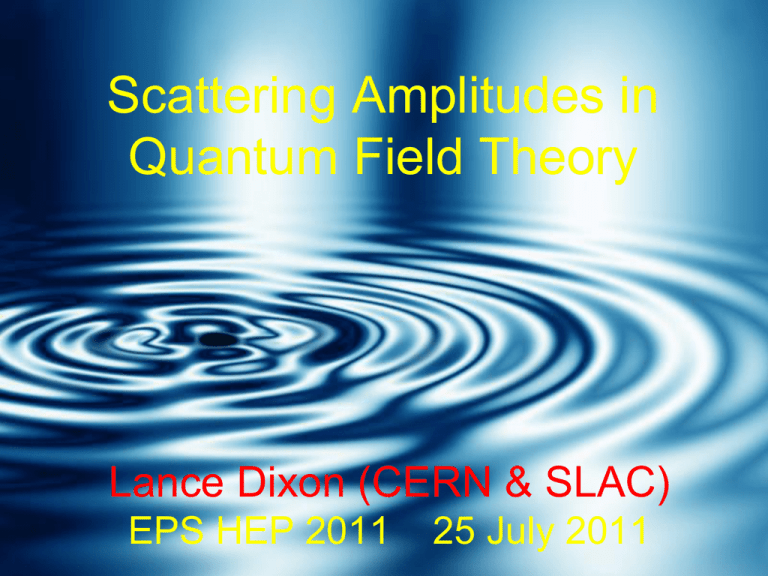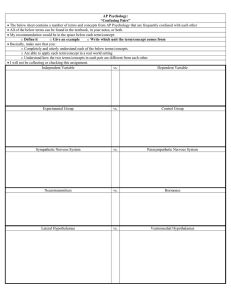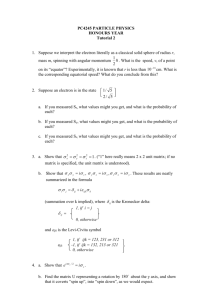LDEPSHEP11
advertisement

Scattering Amplitudes in Quantum Field Theory Lance Dixon (CERN & SLAC) EPS HEP 2011 25 July 2011 The S matrix reloaded • Almost everything we know experimentally about gauge theory is based on scattering processes with asymptotic, on-shell states, evaluated in perturbation theory. • Nonperturbative, off-shell information very useful, but often more qualitative (except for lattice gauge theory). All perturbative scattering amplitudes can be computed with Feynman diagrams – but that is not necessarily the best way, especially if there is hidden simplicity. On-shell methods can be much more efficient, and provide new insights. Use analytic properties of the S matrix directly, not Feynman diagrams. • • • L. Dixon Scattering Amplitudes in QFT EPS HEP11 Grenoble 25 July 2 Three Applications of On-Shell Methods • QCD: a very practical application, needed for quantifying LHC backgrounds to new physics talk by G. Zanderighi • N=4 super-Yang-Mills theory: lots of simplicity, both manifest and hidden. A particularly beautiful application of on-shell and related methods – see also talk by N. Beisert • N=8 supergravity: amazingly good UV behavior, beyond expectations, unveiled by on-shell methods L. Dixon Scattering Amplitudes in QFT EPS HEP11 Grenoble 25 July 3 The Analytic S-Matrix Bootstrap program for strong interactions: Reconstruct scattering amplitudes directly from analytic properties: “on-shell” information • Poles • Branch cuts Landau; Cutkosky; Chew, Mandelstam; Eden, Landshoff, Olive, Polkinghorne; Veneziano; Virasoro, Shapiro; … (1960s) Analyticity fell out of favor in 1970s with the rise of QCD & Feynman rules Now resurrected for computing amplitudes in perturbative QCD as alternative to Feynman diagrams! Perturbative information now assists analyticity. Works for many other theories too. L. Dixon Scattering Amplitudes in QFT EPS HEP11 Grenoble 25 July 4 Perturbative unitarity bootstrap • S-matrix a unitary operator between in and out states S† S = 1 unitarity relations (cutting rules) for amplitudes • Reconstruct (multi-)loop amplitudes from cuts efficiently, due to simple structure of tree and lower-loop helicity amplitudes • Generalized unitarity reduces everything to (simpler) trees L. Dixon Scattering Amplitudes in QFT EPS HEP11 Grenoble 25 July 5 Granularity vs. Plasticity L. Dixon Scattering Amplitudes in QFT EPS HEP11 Grenoble 25 July 6 Generalized Unitarity (One-loop Plasticity) Ordinary unitarity: put 2 particles on shell Generalized unitarity: put 3 or 4 particles on shell Trees recycled into loops! L. Dixon Scattering Amplitudes in QFT EPS HEP11 Grenoble 25 July 7 Black Holes • “The most perfect macroscopic objects there are in the universe: the only elements in their construction are our concepts of space and time” S. Chandrasekhar L. Dixon Scattering Amplitudes in QFT EPS HEP11 Grenoble 25 July 8 Scattering Amplitudes • The most perfect microscopic objects there are in the universe? • When gravitons scatter, the only elements in the construction are again our concepts of space and time L. Dixon Scattering Amplitudes in QFT h h h h EPS HEP11 Grenoble 25 July 9 g g Gauge Theory Amplitudes g • Seem less universal at first sight: • Have to specify gauge group G, representation R for matter fields, etc. • However, full amplitudes An can be assembled from universal, G,R-independent “color-stripped” or “color-ordered” amplitudes An : color L. Dixon Scattering Amplitudes in QFT universal EPS HEP11 Grenoble 25 July 10 g Through the clouds of gas and dust • Obscure astrophysical black holes, but also make them detectable, their physics much richer L. Dixon Scattering Amplitudes in QFT EPS HEP11 Grenoble 25 July 11 Through the clouds of soft interactions • Obscure hard QCD amplitudes at their core, but also make the physics much richer F. Krauss L. Dixon Scattering Amplitudes in QFT EPS HEP11 Grenoble 25 July 12 Relativistic Gauge Amplitudes • In relativistic limit, particle masses mb ,mW, mt , … become unimportant, making gauge amplitudes still more universal. • In QCD, if we could go to extremely high energies, then asymptotic freedom, as 0, we would need only leading order cross sections, i.e. tree amplitudes = L. Dixon Scattering Amplitudes in QFT +… EPS HEP11 Grenoble 25 July 13 Universal Tree Amplitudes • For pure-glue trees, matter particles (fermions, scalars) cannot enter, because they are always pair-produced • Pure-glue trees are exactly the same in QCD as in maximally supersymmetric gauge theory, N=4 super-Yang-Mills theory: QCD L. Dixon = Scattering Amplitudes in QFT +… = EPS HEP11 Grenoble N=4 SYM 25 July 14 Tree-Level Simplicity • When very simple QCD tree amplitudes were found, first in the 1980’s Parke-Taylor formula (1986) … the simplicity was secretly due to N=4 SYM L. Dixon Scattering Amplitudes in QFT EPS HEP11 Grenoble 25 July 15 All N=4 SYM trees in closed form Drummond, Henn, 0808.2475 For example, for 3 (-) gluon helicities and [n-3] (+) gluon helicities, extract from: 5 (-) gluon helicities and [n-5] (+) gluon helicities: These formulas can immediately be used for QCD (with external quarks too) LD, Henn, Plefka, Schuster, 1010.3991 L. Dixon Scattering Amplitudes in QFT EPS HEP11 Grenoble 25 July 16 Beyond trees • For precise Standard Model predictions at colliders [talk by Zanderighi] • For investigating of formal properties of gauge theories and gravity need loop amplitudes Where the fun really starts – textbook methods quickly fail, even with very powerful computers L. Dixon Scattering Amplitudes in QFT EPS HEP11 Grenoble 25 July 17 Different theories differ at loop level N=4 SYM • QCD at one loop: coefficients are all rational functions – determine algebraically from products of trees using (generalized) unitarity well-known scalar one-loop integrals, master integrals, same for all amplitudes rational part L. Dixon Scattering Amplitudes in QFT EPS HEP11 Grenoble 25 July 18 Gauge Hierarchy of Amplitude Simplicity L. Dixon Scattering Amplitudes in QFT EPS HEP11 Grenoble 25 July 19 N=4 super-Yang-Mills theory all states in adjoint representation, all linked by N=4 supersymmetry • Interactions uniquely specified by gauge group, say SU(Nc), 1 coupling g • Exactly scale-invariant (conformal) field theory: b(g) = 0 for all g L. Dixon Scattering Amplitudes in QFT EPS HEP11 Grenoble 25 July 20 Planar N=4 SYM and AdS/CFT • In the ’t Hooft limit, fixed, planar diagrams dominate • AdS/CFT duality suggests that weak-coupling perturbation series in l for large-Nc (planar) N=4 SYM should have hidden structure, because large l limit weakly-coupled gravity/string theory on large-radius AdS5 x S5 L. Dixon Scattering Amplitudes in QFT EPS HEP11 Grenoble Maldacena 25 July 21 AdS/CFT in one picture L. Dixon Scattering Amplitudes in QFT EPS HEP11 Grenoble 25 July 22 Four Remarkable, Related Structures Unveiled Recently in Planar N=4 SYM Scattering • Exact exponentiation of 4 & 5 gluon amplitudes • Dual (super)conformal invariance • Strong coupling “soap bubbles” • Equivalence between (MHV) amplitudes & Wilson loops Properties all related in some way to AdS/CFT. To be explored in more detail tomorrow in talk by N. Beisert Outstanding question: Can these structures be used to solve exactly for all planar N=4 SYM amplitudes? L. Dixon Scattering Amplitudes in QFT EPS HEP11 Grenoble 25 July 23 Dual Conformal Invariance Broadhurst (1993); Lipatov (1999); Drummond, Henn, Smirnov, Sokatchev, hep-th/0607160 Conformal symmetry acting in momentum space, on dual or sector variables xi First seen in N=4 SYM planar amplitudes in the loop integrals x1 x4 k x2 x5 invariant under inversion: x3 L. Dixon Scattering Amplitudes in QFT EPS HEP11 Grenoble 25 July 24 Dual conformal invariance at higher loops • Simple graphical rules: 4 (net) lines into inner xi 1 (net) line into outer xi • Dotted lines are for numerator factors All integrals entering planar 4-point amplitude at 2, 3, 4, and 5 loops are of this form! Bern, Czakon, LD, Kosower, Smirnov, hep-th/0610248 Bern, Carrasco, Johansson, Kosower, 0705.1864 L. Dixon Scattering Amplitudes in QFT EPS HEP11 Grenoble 25 July 25 Constrained Amplitudes • After all loop integrations are performed, amplitude depends only on external momentum invariants, • Dual conformal invariance (xi inversion) fixes form of amplitude, up to functions of invariant cross ratios: • Since , no such variables for n=4,5 4,5 gluon amplitudes totally fixed, to 6 1 exact-exponentiated form (BDS ansatz) • For n=6, precisely 3 ratios: 5 + 2 cyclic perm’s L. Dixon Scattering Amplitudes in QFT 4 EPS HEP11 Grenoble 2 3 25 July 26 Constrained Integrands • Before loop integrations performed, even 4-gluon amplitude has invariant integrands. But only a limited number of possibilities. • Use generalized unitarity to determine correct linear combination, by matching to a general ansatz for the integrand. • Convenient to chop loop amplitudes all the way down to trees. • For example, at 3 loops, one encounters the product of a 5-point tree and a 5-point one-loop amplitude: Cut 5-point loop amplitude further, into (4-point tree) x (5-point tree), in all inequivalent ways: L. Dixon Scattering Amplitudes in QFT EPS HEP11 Grenoble 25 July 27 Strategy works through at least 5 loops Bern, Carrasco, Johansson, Kosower, 0705.1864 L. Dixon Scattering Amplitudes in QFT EPS HEP11 Grenoble 25 July 28 Beyond the planar approximation • Beyond the large-Nc limit, or in theories other than N=4 SYM, dual conformal invariance doesn’t hold. • However, another recently discovered set of relations for integrands can be used to get many contributions from a handful of planar ones: • “Color-kinematics duality”, or BCJ relations. • Old history (at 4-point tree level) dating back to discovery of radiation zeroes. L. Dixon Scattering Amplitudes in QFT EPS HEP11 Grenoble 25 July 29 Radiation Zeroes • Mikaelian, Samuel, Sahdev (1979) computed g • Found “radiation zero” at • Held independent of (W,g) helicities • Implies a connection between – “color” (here electric charge Qd) – kinematics (cosq) L. Dixon Scattering Amplitudes in QFT EPS HEP11 Grenoble 25 July 30 Color-Kinematic Duality • Extend to other 4-point non-Abelian gauge amplitudes Zhu (1980), Goebel, Halzen, Leveille (1981) • Massless all-adjoint gauge theory: • Group theory 3 terms not independent (color Jacobi identity): • In suitable “gauge”, find “kinematic Jacobi identity”: • Structure extends also to arbitrary number of legs Bern, Carrasco, Johansson, 0805.3993 L. Dixon Scattering Amplitudes in QFT EPS HEP11 Grenoble 25 July 31 Color-Kinematic Duality at loop level • Consider any 3 graphs connected by a Jacobi identity • Color factors obey Cs • = Ct – Cu = nt – nu Duality requires ns • Powerful constraint on structure of integrands • Can always check afterwards using generalized unitarity L. Dixon Scattering Amplitudes in QFT EPS HEP11 Grenoble 25 July 32 Simple 3 loop example Using we can relate non-planar topologies to planar ones = 2 3 1 4 - In fact all N=4 SYM 3 loop topologies related to (e) Carrasco, Johansson, 1103.3298 L. Dixon Scattering Amplitudes in QFT EPS HEP11 Grenoble 25 July 33 UV Finiteness of N=8 Supergravity? • Quantum gravity is nonrenormalizable by power counting: the coupling, Newton’s constant, GN = 1/MPl2 is dimensionful • String theory cures divergences of quantum gravity by introducing a new length scale at which particles are no longer pointlike. • Is this necessary? Or could enough (super)symmetry, allow a point particle theory of quantum gravity to be perturbatively ultraviolet finite? • A positive answer would have profound implications, even if it is just in a “toy model”. • Investigate by computing multi-loop amplitudes in N=8 supergravity DeWit, Freedman (1977); Cremmer, Julia, Scherk (1978); Cremmer, Julia (1978-9) and then examining their ultraviolet behavior. Bern, Carrasco, LD, Johansson, Kosower, Roiban, hep-th/0702112; BCDJR, 0808.4112, 0905.2326, 1008.3327, 1108.nnnn L. Dixon Scattering Amplitudes in QFT EPS HEP11 Grenoble 25 July 34 28 = 256 massless states, ~ expansion of (x+y)8 SUSY 24 = 16 states ~ expansion of (x+y)4 L. Dixon Scattering Amplitudes in QFT EPS HEP11 Grenoble 25 July 35 Gravity from gauge theory (tree level) Kawai, Lewellen, Tye (1986) derived relations between open & closed string amplitudes Low-energy limit gives N=8 supergravity amplitudes as quadratic combinations of N=4 SYM amplitudes respecting factorization of Fock space, L. Dixon Scattering Amplitudes in QFT EPS HEP11 Grenoble , 25 July 36 Gravity from color-kinematics duality Given a color-kinematics satisfying gauge amplitude, e.g. with , then gravity amplitude is simply given by erasing color factors and squaring numerators, e.g. Bern, Carrasco, Johansson, 0805.3993, 1004.0476; Bern, Dennen, Huang, Kiermaier, 1004.0693 Like KLT relations, gravity = (gauge theory)2, amplitudes respect factorization of Fock space, L. Dixon Scattering Amplitudes in QFT EPS HEP11 Grenoble 25 July 37 AdS/CFT vs. KLT AdS = CFT gravity weak = gauge theory strong KLT gravity weak L. Dixon = Scattering Amplitudes in QFT (gauge theory)2 weak EPS HEP11 Grenoble 25 July 38 KLT Copying N=4 SYM amplitude (full color, not just planar), plus KLT relations & generalized unitarity, gives all information needed to construct N=8 amplitude at same loop order. For example, at 3 loops: N=8 SUGRA N=4 SYM N=4 SYM rational function of Lorentz products of external and cut momenta; all state sums already performed With a color-kinematics-duality respecting gauge amplitude, passing to the gravity amplitude is trivial! L. Dixon Scattering Amplitudes in QFT EPS HEP11 Grenoble 25 July 39 “Color-kinematics duality” at 3 loops Bern, Carrasco, Johansson, 0805.3993, 1004.0476 N=4 N=8 SYM SUGRA [ ]2 [ ]2 Linear in [ 4 loop amplitude has similar dual representation! [ ]2 ]2 [ ]2 BCDJR, to appear L. Dixon Scattering Amplitudes in QFT EPS HEP11 Grenoble 25 July 40 N=8 SUGRA as good as N=4 SYM in UV Amplitude representations have been found through 4 loops with same UV behavior as N=4 SYM same critical dimension Dc for UV divergences: • But N=4 SYM is known to be finite for all L. • Therefore, either this pattern has to break at some point (L=5???) or else N=8 supergravity would be a perturbatively finite point-like theory of quantum gravity, against all conventional wisdom! • L=5 results critical (several bottles of wine at stake) L. Dixon Scattering Amplitudes in QFT EPS HEP11 Grenoble 25 July 41 Conclusions • Scattering amplitudes have a very rich structure, not only in gauge theories of Standard Model, but especially in highly supersymmetric gauge theories and supergravity. • Much of this structure is impossible to see using Feynman diagrams, but has been unveiled with the help of unitarity-based methods • Among other applications, these methods have • had practical payoffs in the “NLO QCD revolution” • provided clues that planar N=4 SYM amplitudes might be solvable in closed form • shown that N=8 supergravity has amazingly good ultraviolet properties • More surprises are surely in store in the future! L. Dixon Scattering Amplitudes in QFT EPS HEP11 Grenoble 25 July 42 From “science” to “technology” N=4 SYM QCD L. Dixon Scattering Amplitudes in QFT EPS HEP11 Grenoble 25 July 43 Extra Slides L. Dixon Scattering Amplitudes in QFT EPS HEP11 Grenoble 25 July 44 Many more QCD trees from N=4 SYM Gluinos are adjoint, quarks are fundamental Color not a problem because it’s easily manipulated – common to work with “color stripped” amplitudes anyway No unwanted scalars can enter amplitude with only one fermion line: Impossible to destroy them once created, until you reach two fermion lines: Can use flavor of gluinos to pick out desired QCD amplitudes, through (at least) three fermion lines (all color/flavor orderings), and including V+jets trees LD, Henn, Plefka, Schuster, 1010.3991 L. Dixon Scattering Amplitudes in QFT EPS HEP11 Grenoble 25 July 45 Infinities • “The infinite can be appreciated only by the finite.” - J. Brodsky, Watermark • “The finite can be appreciated only after removing the infinite.” - Quantum Field Theory Two types of infinities: • Ultraviolet renormalization • Infrared factorization L. Dixon Scattering Amplitudes in QFT EPS HEP11 Grenoble 25 July 46 Dimensional Regulation in the IR One-loop IR divergences are of two types: Soft Collinear (with respect to massless emitting line) Overlapping soft + collinear divergences imply leading pole is at 1 loop at L loops L. Dixon Scattering Amplitudes in QFT EPS HEP11 Grenoble 25 July 47 Infrared Factorization Loop amplitudes afflicted by IR (soft & collinear) divergences jet function (spin-dependent) hard function (finite as e 0) soft function (color-dependent) In any theory, including QCD, S and J exponentiate. Surprise: for planar N=4 SYM, in some cases, full amplitude does too. L. Dixon Scattering Amplitudes in QFT EPS HEP11 Grenoble 25 July 48 Large Nc Planar Simplification coefficient of • Planar limit color-trivial: absorb S into Ji • Each “wedge” is the square root of the well-studied process “gg 1” (the exponentiating Sudakov form factor): L. Dixon Scattering Amplitudes in QFT EPS HEP11 Grenoble 25 July 49







